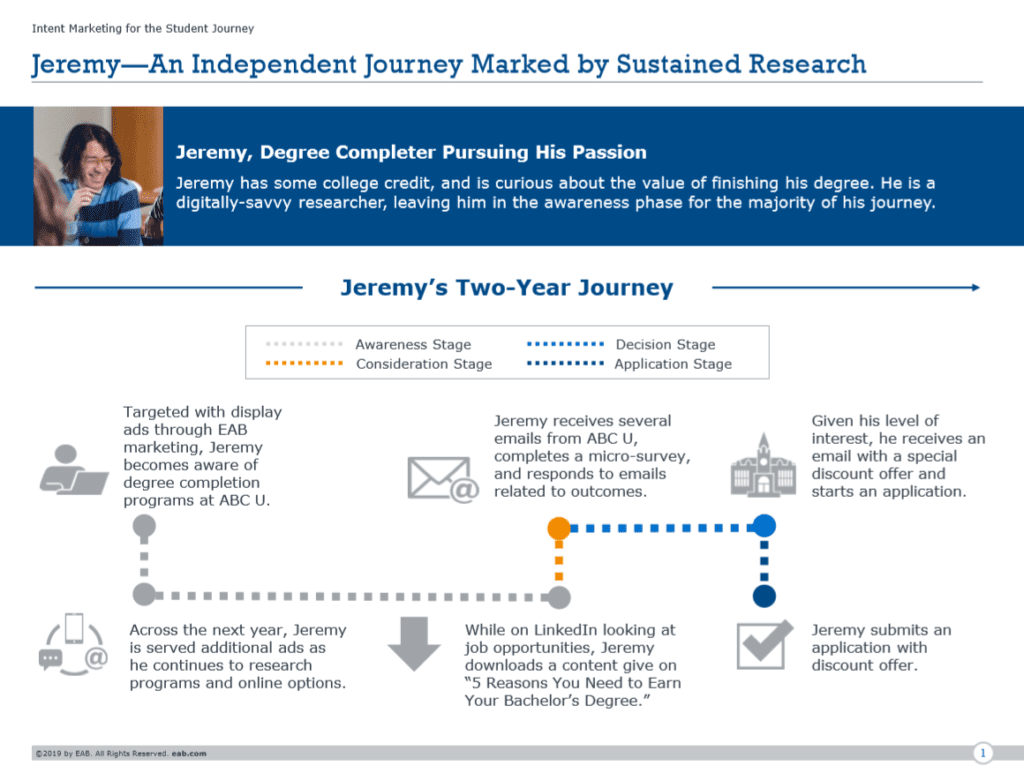The graduate marketing strategy that tripled leads
April 18, 2019
Recently, I heard a director of admissions for a full time MBA program share that it takes their inquiries anywhere from three days to two years to start an application.
This struck me and validated my belief that every student journey is unique, which we know makes marketing to and recruiting adult learners extremely challenging. Not only are audiences hard to identify, but the pathways by which adult learners find their way to your graduate, online, certificate, and undergraduate degree completion programs vary greatly. Every prospective adult learner has unique motivations, goals, and timelines.
This resource is part of the Develop Outcomes-Focused Recruitment Messages for Adult Learners Roadmap. Access the Roadmap for stepwise guidance with additional tools and research.
To reach and engage adult learners, you must design campaign strategies that are hyper-responsive to individual needs. A one-size-fits-all approach doesn’t work. But how do you scale this level of personalization? At the same time as I’ve been pondering this question, “intent marketing” has emerged as a popular topic in marketing communities, largely because some of the leading consumer companies are using it.
At EAB’s Adult Learner Recruitment, it’s a part of our DNA to research and test any idea before we recommend it. So across the last year, we examined whether marketing according to student intent—using real-time data to be responsive to specific micro moments and behaviors—could impact our client’s results.
What we found was pretty remarkable. The campaigns we ran that used an intent marketing approach generated three times the number of leads compared to typical campaigns and saw a 30% average increase in campaign response rate.
What 1,000 adult learners shared about their the motivations and preferences
The shifting marketing funnel and the rise of intent marketing
As we learned in our 2015 research study Recruiting the Silent Funnel, which highlighted insights from 250+ conversations with COE leaders, adult learners no longer follow conventional paths to decision. The study found that at many colleges and universities more than 70% of applicants are stealth—or unknown to an institution before they start an application. The reality is that digital technologies and shifting consumer expectations are changing the marketing funnel everywhere, not just in higher education.
One blog by Google described the environment this way:
“Forget everything you know about the marketing funnel. Today, people are no longer following a linear path from awareness to consideration to purchase. They are narrowing and broadening their consideration set in unique and unpredictable moments. People turn to their devices to get immediate answers. And every time they do, they are expressing intent and reshaping the traditional marketing funnel along the way.”
Intent marketing is an approach that relies on personalization and real-time response. It introduces time and present-day consumer behavior into the equation, in addition to the historical data that marketing traditionally relies upon. It accepts the unpredictability of today’s consumer—and reacts to specific micro moments. In other words, regardless of who a person is or what they did in the past—when someone sends digital signals that show intent to buy (or, equally important, a deceleration or pause in interest)—marketers need to respond accordingly with communications that reflect a true understanding of the prospects’ needs.
EAB is applying these principles of intent marketing to be more responsive to prospective students’ needs, and therefore drive better engagement and results. Here are two representative student journeys that highlight this approach.
Sample student journey: Targeting a stealth applicant during a period of independent research
Let’s imagine one prospective adult student of an undergraduate degree completion program—we’ll call him Jeremy. Jeremy has some college credit and is curious about the value of finishing his degree. He hasn’t decided where he will enroll, or even if he will return to school at all. He is in his mid-20s, technologically savvy, and willing to wait as long as it takes to make the right enrollment decision. He may be saving money or evaluating how school will fit into his current lifestyle, and how he will balance it with work.
Prospective students like Jeremy often spend considerable time, multiple years in some cases, in what experts traditionally refer to as the awareness phase of the marketing funnel, which is marked predominantly by self-service research.
EAB’s Adult Learner Recruitment is working with schools to identify prospects like Jeremy early—because if you reach them too late, you risk missing the opportunity to influence their research and you may never make it into their consideration at all. On the other hand, if you make incorrect assumptions about their readiness to engage, you might annoy or alienate them—a mistake intent marketing helps prevent.
HOW MACHINE LEARNING CAN BE USED IN ADULT STUDENT MARKETING
One way we help schools identify right-fit prospective students like Jeremy is through machine learning enabled modeling. Using consumer analytics, we develop a robust picture of each school’s high affinity student profiles and leverage those insights throughout the prospective student’s journey. For example, by serving Jeremy digital ads during his stealth shopping phase that have school-specific insights that are likely to resonate, we can build awareness, increasing the likelihood that he keeps a school in his consideration set. For example, after a year of independent research, he may be convinced that school X can meet his needs and is ready to download a prospectus from LinkedIn in exchange for his email.
EAB is facilitating the long beginning of Jeremy’s journey with persistent advertising and getting the right read on his ultimate intent—so we can ensure he applies with a properly timed offer, like a discounted application fee.

Sample student journey: Listening and personalizing with micro-surveys
In another example of how we can use intent-based marketing to be responsive to a specific student journey, we’ll use a student named Jonathan. Jonathan is an ambitious working parent, who’s seeking a promotion at work. He also has a growing family at home and is thinking about his long-term career aspirations.
We can help schools target prospective graduate students like Jonathan based on age, title, and industry. In this case, he looks like a high-affinity prospect for an MBA program. Through LinkedIn targeting, Jonathan might receive an ad asking him to tell XYZ University about why he wants to earn his MBA degree. Let’s say he engages with the ad and submits a brief two-question micro survey. In the survey, Jon is asked, “What is your biggest concern about earning your MBA?” to which he selects: Balancing school with family and work.
We can then use Jonathan’s survey response to trigger an email that specifically highlights the school’s flexible degree options and graduates’ average time to completion—in direct response to his stated concerns. As one of my favorite marketing quotes says, “Great marketing is actually just great listening.”
Building a connection like this helps Jonathan feel like XYZ University wants to learn about him and that they listened to his concerns, so he continues to engage and receives additional personalized messages from admissions. At the same time in this journey, we would use multi-channel marketing to make sure that Jonathan saw ads with deadline reminders. Across time, with continuous nudging and personalized communication, Jonathan will finally apply for a part-time program at MBA.
Your prospective students are accustomed to sophisticated consumer interactions. Whether they are shopping on Amazon or ordering lunch through Uber Eats, they have been conditioned to expect easy, personalized experiences and higher education is not exempt from these expectations.
Every prospect you engage with is different, and every journey to enrollment follows a different path. The key to enrollment success in this environment is understanding that—and being able to respond. I am excited to be partnering with our clients to bring intent marketing to thousands of individual student journeys each year.
More Blogs

3 things you need to know about the shifting adult learner market

How Houston Baptist University tripled graduate student enrollment
